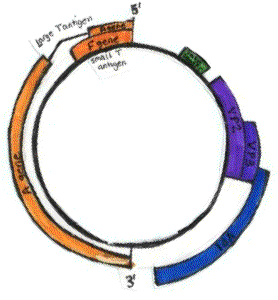
The Biology
These small, double-stranded DNA viruses have many unique properties. For example, the DNA is the only covalently closed circular DNA.
Morphology: The virion is spherically shaped, naked and contains icosohedral symmetry (T = 7). The are the only icosohedrally symmetric virion which contains skew symmetry.
Replication: Replication occurs in the nucleus (where the virus
uses the host polymerase). Virions are released from the cell by
lysis.
What is the etymology?
The Papova family was named for its three distinguished viruses:
Human PApilloma virus
Rabbit POlyoma virus
Simian VAcuolating Agents
What are the subclasses?
Polyomavirus and Papillomavirus are the two genera of papovavirida. The table below summarizes their similarities and differences:
|
|
|
|
|
Genome |
|
|
|
Morphology |
|
|
|
Other Differences |
| |
|
Pathogenesis |
Most are asymptomatic, although can be oncogenic in hamsters |
Cause various types of warts, epidermodysplasia verruciformis |
|
Representative Viruses |
JC Virus
BK Virus
Simian Virus 40 A completely sequenced animal virus used frequently as a cloning vector.
|
At least 62 strains of Human Papillomaviruses
|
What are the genomic properties?
The genomic features of papoviridae exemplify the beauty and creativity of nature. The circular genome uses nested genes, overlapping genes and differential splicing to squeeze the maximum amount of genetic material in the smallest space.
Two kinetic classes exist, the early and the late genes.The early genes (E1-E8) code for the protein which is need in early functioning (e. g. for replication). TheT antigen directs the host polymerase to the viral genome. The late genes (L1-2) code for the major and minor capsid protiens. In the papilloma virus, the E genes are coded on Watson and the L genes are coded on Crick.
Human Papillomavirus encodes seven early proteins and two late proteins. The function of these proteins are as follows:
E1: viral replication
E2: Viral replication and transcription
E4: destabliliation of cytokeratin network
E5:mediation of mitogenic signals of growth factors
E6: cellular transformation
E7: cellular transformation
L1: major viral coat protein
L2: minor viral coat proten

The above picture, which arranges the genome
(normally circular) in a linearly fashion, demonstrates the
similarities from SV40 and HP16. As you can see, the genes in HP16
are in three separate reading frames. Several of the genes are nested
and overlapping.
For more information, check out the HPV Sequences
Database.
SV40
Here is a picture of the Simian Virus 40. This was the first virus to be completly sequenced. Although the genome of this polyomavirus is not exactly the same as the papillomaviruses, we can learn much from its methods of transcription.

Properties that this virus illustrates:
Differential Splicing: The large T antigen is the product of two genes which have been spliced together.
Overlapping Genes: These genes have overlapping sequences. Examples are VP2 and VP3, VP3 and VP1 and VP2 and VP3.
Nested Genes: These genes have overlapping sequences, but do not share the same start or stop codon. VP1 and VP2 are nested genes. Nested genes must also have different reading frames. Else, transcription of VP1 would be intreruppted at the STOP codon region of VP2 and VP1.
As you can see, this virus encodes on both the Watson and Crick strands of the DNA.